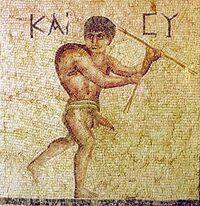Religion:Cacodemon
From HandWiki

Tychodaimon,[citation needed] the opposite of the Kakodaimon
A cacodemon (or cacodaemon) is an evil spirit or (in the modern sense of the word) a demon. The opposite of a cacodemon is an agathodaemon or eudaemon, a good spirit or angel. The word cacodemon comes through Latin from the Ancient Greek κακοδαίμων kakodaimōn, meaning an "evil spirit," whereas daimon would be a neutral spirit in Greek and Tychodaimon[citation needed] would be a good spirit. In psychology, cacodemonia (or cacodemomania) is a form of insanity in which the patient believes that they are possessed by an evil spirit. The first known occurrence of the word cacodemon dates to 1593. In Shakespeare's Richard III Act 1 Scene 3, Queen Margaret calls Richard a "cacodemon" for his foul deeds and manipulations.[1]
In popular culture
- In the book & tv show The Magicians by Lev Grossman, the main characters each have a Cacodemon magically implanted into their backs.
- Kelley Armstrong's Otherworld novels feature cacodemons and eudemons, some of whom have produced semi-human-like progeny; in this context eudemons are not so much "good" as "non-chaotic".
- Deicide's second album, Legion, contains a song called "Satan Spawn, The Caco-Daemon".
- There is a painting by Paul Klee called Cacodaemonic (1916)
- There is a boulder in Squamish, Canada called Cacodemon, it is the location of the climb Dreamcatcher, a 5.14d (9a) first climbed by Chris Sharma.
Games
- In the Dungeons & Dragons role-playing game, Cacodaemon is a powerful Yugoloth (daemon), much like the Baatezu (devils) and the Tanar'ri (demons).
- In the first edition of Advanced Dungeons & Dragons, "Cacodemon" is a seventh level magic-user spell. It was used to summon a type IV, V, or VI demon to the player character's location in the game world. The spell was omitted from the early versions of the second edition of the game, and was later revised in the Planescape product line, in which it could summon a variety of powerful tanar'ri or baatezu. The spell was eventually phased out in the third edition of the Dungeons & Dragons game in favor of a more comprehensive creature-summoning spell.
- In fantasy video game Baldur's Gate II, the BioWare Infinity Engine equivalent of the "Cacodemon" spell is known as "Cacofiend".
- In third edition Dungeons & Dragons, the (in)famous namesake beast itself ("Cacodaemon") was later revised into the "Cacoloth" class of Yugoloth, whose sole purpose is to act as bodyguards and servants for the "Oinoloth" and the "Ultraloths."
- In the Fantasy world Glorantha Cacodemon is the god of ogres
- In the Doom series of computer games developed by id software, Cacodemons are an enemy, depicted as levitating, spherical, one-eyed monsters. They fire burning projectiles and have so far appeared in every game of the series, becoming somewhat of an icon for Doom as a whole.[2]
- In Final Fantasy XI MMORPG, the Terrestrial Avatar Diabolos uses a special attack called "Cacodemonia."
- In Anarchy Online MMORPG, a pet that one of the professions can summon is the Cacodemon.
- In Wizardry V, Cacodaemons are large red demons encountered on floor 777.[3]
- In the Pathfinder Roleplaying Game, cacodaemons appear as a low-level demon with features similar to the ones found in Doom.
- In Smite, there is a Cacodemon skin for the playable God Ymir.
- In Magic: the Gathering, Dread Cacodemon is a card from the Commander expansion.
- In Dungeon Crawl Stone Soup, Cacodaemons are large, yellow, obese demons whose primary attacks are attempting to mutate the player, or corrode them with an acid spit.
See also
- Sinistrari, Ludavico Maria. Demoniality; or, Incubi and succubi; a treatise wherein is shown that there are in existence on earth rational creatures besides man, endowed like him with a body and a soul... Amazon Kindle Edition, April 16, 2013.
- Genius (mythology)
- Greek mythology
- Greek religion
References
- ↑ Richard III.1.3
- ↑ Cacodemon. Doom Wiki. Accessed 25 September 2016
- ↑ "Eudemons & Cacodemons". Demonology 101. Kelley Armstrong. http://www.kelleyarmstrong.com/eDemons.htm#Eudemons%20&%20Cacodemons.

